机场应急救援 英文版
- 格式:ppt
- 大小:1.88 MB
- 文档页数:38
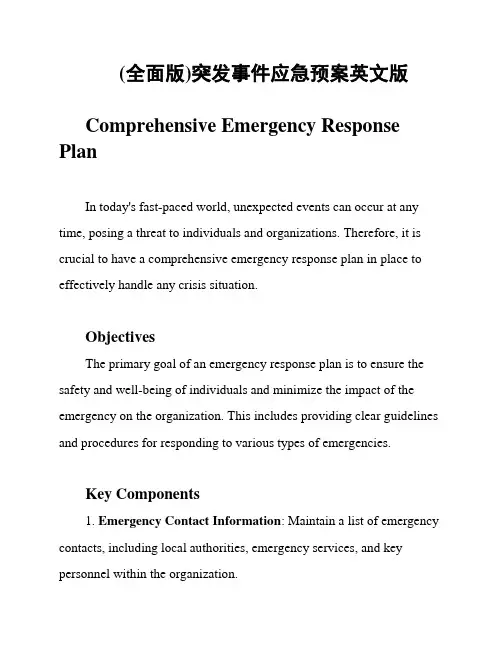
(全面版)突发事件应急预案英文版Comprehensive Emergency Response PlanIn today's fast-paced world, unexpected events can occur at any time, posing a threat to individuals and organizations. Therefore, it is crucial to have a comprehensive emergency response plan in place to effectively handle any crisis situation.ObjectivesThe primary goal of an emergency response plan is to ensure the safety and well-being of individuals and minimize the impact of the emergency on the organization. This includes providing clear guidelines and procedures for responding to various types of emergencies.Key Components1. Emergency Contact Information: Maintain a list of emergency contacts, including local authorities, emergency services, and key personnel within the organization.2. Communication Plan: Establish a communication protocol for notifying employees, stakeholders, and the public about the emergency situation.3. Evacuation Procedures: Develop clear evacuation routes and procedures for safely evacuating individuals from the premises.4. Emergency Supplies: Stock up on essential emergency supplies such as first aid kits, flashlights, and food/water rations.5. Training and Drills: Conduct regular training sessions and drills to ensure that employees are familiar with the emergency response plan.Response ProtocolIn the event of an emergency, the following steps should be followed:1. Assess the Situation: Quickly assess the nature and severity of the emergency to determine the appropriate response.2. Activate the Emergency Response Team: Notify the designated emergency response team to coordinate the response efforts.3. Implement the Response Plan: Follow the established procedures and guidelines outlined in the emergency response plan.4. Communicate Effectively: Keep all stakeholders informed about the situation and provide regular updates as necessary.5. Evaluate and Learn: After the emergency has been resolved, conduct a thorough review of the response efforts to identify areas for improvement.ConclusionA well-prepared emergency response plan is essential for effectively managing crisis situations and ensuring the safety of individuals. By following the key components and response protocol outlined in this document, organizations can mitigate the impact of emergencies and protect their assets.。
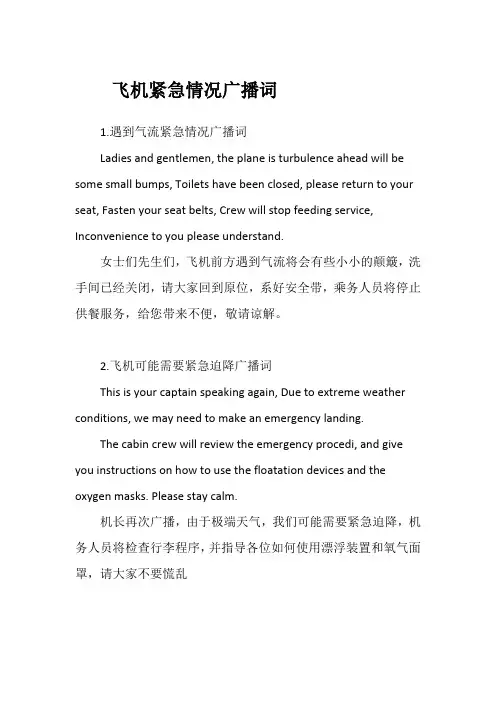
飞机紧急情况广播词1.遇到气流紧急情况广播词Ladies and gentlemen, the plane is turbulence ahead will be some small bumps, Toilets have been closed, please return to your seat, Fasten your seat belts, Crew will stop feeding service, Inconvenience to you please understand.女士们先生们,飞机前方遇到气流将会有些小小的颠簸,洗手间已经关闭,请大家回到原位,系好安全带,乘务人员将停止供餐服务,给您带来不便,敬请谅解。
2.飞机可能需要紧急迫降广播词This is your captain speaking again, Due to extreme weather conditions, we may need to make an emergency landing.The cabin crew will review the emergency procedi, and give you instructions on how to use the floatation devices and the oxygen masks. Please stay calm.机长再次广播,由于极端天气,我们可能需要紧急迫降,机务人员将检查行李程序,并指导各位如何使用漂浮装置和氧气面罩,请大家不要慌乱3.飞机遭遇颠簸紧急情况广播词Folks, this is the captain speaking from the cockpit, We are experiencing a lot of turbulence and I'm turning on the fasten seatbelt sign. Please remain in your seats.各位,现在是机长讲话,我们正在经历很大的颠簸,我正在打开安全带指示灯,请各位在座位上坐好。

营救直升飞机英语作文下载温馨提示:该文档是我店铺精心编制而成,希望大家下载以后,能够帮助大家解决实际的问题。
文档下载后可定制随意修改,请根据实际需要进行相应的调整和使用,谢谢!并且,本店铺为大家提供各种各样类型的实用资料,如教育随笔、日记赏析、句子摘抄、古诗大全、经典美文、话题作文、工作总结、词语解析、文案摘录、其他资料等等,如想了解不同资料格式和写法,敬请关注!Download tips: This document is carefully compiled by theeditor. I hope that after you download them,they can help yousolve practical problems. The document can be customized andmodified after downloading,please adjust and use it according toactual needs, thank you!In addition, our shop provides you with various types ofpractical materials,such as educational essays, diaryappreciation,sentence excerpts,ancient poems,classic articles,topic composition,work summary,word parsing,copyexcerpts,other materials and so on,want to know different data formats andwriting methods,please pay attention!The helicopter rescue mission was intense. We were flying at high speed, trying to reach the stranded hikers before darkness fell. The wind was howling, making it difficult to maintain control of the aircraft. The pilot skillfully maneuvered through the treacherous terrain, dodging trees and rocks. It was a race against time.As we approached the location where the hikers werelast seen, we spotted them waving frantically from a small clearing. The relief on their faces was palpable. We quickly descended, hovering just above the ground to create a safe landing zone. The pilot skillfully touched down, and the team of rescuers jumped out, ready to assist.The hikers were exhausted and injured, but theirspirits were high. They had been stranded for days, surviving on limited supplies. We provided them with food, water, and medical attention. The gratitude in their eyes was overwhelming. They thanked us profusely, expressingtheir deep appreciation for our efforts.With the hikers safely on board, we took off once again, this time heading back to the base. The journey back wasjust as challenging as the one before. The wind was even stronger now, threatening to push us off course. The pilot had to constantly adjust the controls to maintain stability. It was a nerve-wracking experience, but we knew we had to stay focused.Finally, after what felt like an eternity, we reached the base. The hikers were immediately taken to the hospital for further treatment. We were exhausted but satisfied with a job well done. The sense of accomplishment was indescribable.As we debriefed, we reflected on the mission. It was a reminder of the importance of teamwork and the dedicationof the rescue personnel. Each member of the team played a crucial role in the success of the mission. From thepilot's expert flying skills to the rescuers' quickthinking and medical expertise, it was a true display ofheroism.We knew that there would be more missions like this in the future. The world can be a dangerous place, and people will continue to find themselves in need of rescue. But we were ready. We had the training, the skills, and the determination to save lives. And that's exactly what we would continue to do.。

营救直升飞机英语作文Rescue Helicopter。
Helicopters are an essential tool in search and rescue operations. They are able to reach remote and inaccessible areas quickly and efficiently, making them invaluable in saving lives in emergency situations. One such rescue helicopter mission that stands out in my mind is the daring rescue of a group of hikers stranded on a mountain during a snowstorm.It was a cold winter day when the distress call came in.A group of hikers had set out on a trek up the mountain,but had become lost and disoriented in the blizzard conditions. With nightfall approaching and temperatures dropping rapidly, it was clear that time was of the essence. The local search and rescue team immediately sprang into action, dispatching a rescue helicopter to locate and evacuate the stranded hikers.As the helicopter made its way towards the mountain, the pilot faced treacherous conditions with strong winds and limited visibility. Despite the challenging circumstances, the pilot skillfully navigated thehelicopter through the storm, relying on their training and experience to safely reach the stranded hikers.Upon locating the group, the rescue team quickly sprang into action, lowering a rescue harness down to the hikers. One by one, they were hoisted up into the helicopter, their faces filled with relief and gratitude as they were brought to safety. The rescue operation was a success, thanks to the teamwork and dedication of the search and rescue team.This rescue mission serves as a powerful reminder of the crucial role that helicopters play in saving lives during emergencies. Their ability to reach remote and inaccessible areas quickly and efficiently can mean the difference between life and death in critical situations. The bravery and skill of the rescue team, combined with the advanced technology of the helicopter, make for a formidable force in the face of adversity.In conclusion, the rescue helicopter is a vital tool in search and rescue operations, capable of reaching remote and inaccessible areas quickly and efficiently. The daring rescue of the stranded hikers on the mountain serves as a powerful example of the importance of these helicopters in saving lives during emergencies. The bravery and skill of the rescue team, combined with the advanced technology of the helicopter, make for a formidable force in the face of adversity.。

CCAR-139-II-R1民⽤运输机场突发事件应急救援管理规则(交通运输部令2016年第45号)民⽤运输机场突发事件应急救援管理规则(CCAR-139-II-R1)第⼀章总则第⼀条为了规范民⽤运输机场应急救援⼯作,有效应对民⽤运输机场突发事件,避免或者减少⼈员伤亡和财产损失,尽快恢复机场正常运⾏秩序,根据《中华⼈民共和国民⽤航空法》《中华⼈民共和国突发事件应对法》和《民⽤机场管理条例》,制定本规则。
第⼆条本规则适⽤于民⽤运输机场(包括军民合⽤机场民⽤部分,以下简称机场)及其邻近区域内突发事件的应急救援处置和相关的应急救援管理⼯作。
第三条本规则所指民⽤运输机场突发事件(以下简称突发事件)是指在机场及其邻近区域内,航空器或者机场设施发⽣或者可能发⽣的严重损坏以及其它导致或者可能导致⼈员伤亡和财产严重损失的情况。
本规则所称机场及其邻近区域是指机场围界以内以及距机场每条跑道中⼼点8公⾥范围内的区域。
第四条中国民⽤航空局(以下简称民航局)负责机场应急救援管理⼯作的总体监督检查。
中国民⽤航空地区管理局(以下简称民航地区管理局)负责本辖区内机场应急救援管理⼯作的⽇常监督检查。
机场管理机构应当按照国家、地⽅⼈民政府的有关规定和本规则的要求,制定机场突发事件应急救援预案,并负责机场应急救援⼯作的统筹协调和管理。
使⽤该机场的航空器营运⼈和其他驻场单位应当根据在应急救援中承担的职责制定相应的突发事件应急救援预案,并与机场突发事件应急救援预案相协调,送机场管理机构备案。
机场应急救援⼯作应当接受机场所在地⼈民政府(以下统称地⽅⼈民政府)的领导。
本规则所称地⽅⼈民政府是指机场所在地县级(含)以上⼈民政府。
第五条机场应急救援⼯作应当遵循最⼤限度地抢救⼈员⽣命和减少财产损失,预案完善、准备充分、救援及时、处置有效的原则。
第六条在地⽅⼈民政府领导下、民⽤航空管理部门指导下,机场管理机构负责机场应急救援预案的制定、汇总和报备⼯作,同时负责发⽣突发事件时机场应急救援⼯作的统⼀指挥。
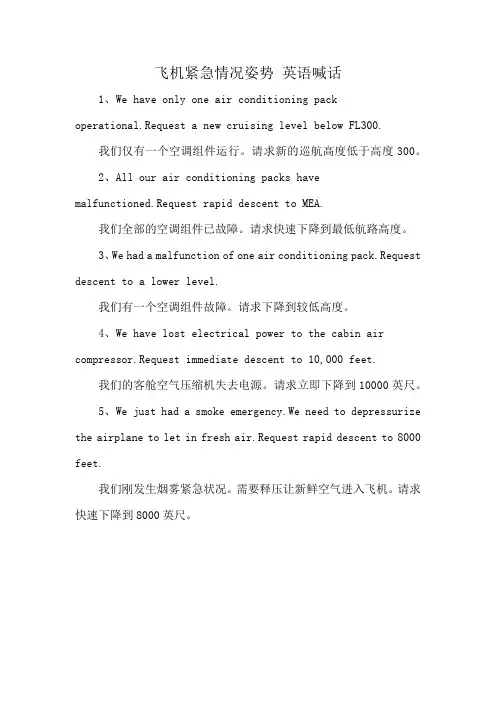
飞机紧急情况姿势英语喊话
1、We have only one air conditioning pack
operational.Request a new cruising level below FL300.
我们仅有一个空调组件运行。
请求新的巡航高度低于高度300。
2、All our air conditioning packs have
malfunctioned.Request rapid descent to MEA.
我们全部的空调组件已故障。
请求快速下降到最低航路高度。
3、We had a malfunction of one air conditioning pack.Request descent to a lower level.
我们有一个空调组件故障。
请求下降到较低高度。
4、We have lost electrical power to the cabin air compressor.Request immediate descent to 10,000 feet.
我们的客舱空气压缩机失去电源。
请求立即下降到10000英尺。
5、We just had a smoke emergency.We need to depressurize the airplane to let in fresh air.Request rapid descent to 8000 feet.
我们刚发生烟雾紧急状况。
需要释压让新鲜空气进入飞机。
请求快速下降到8000英尺。
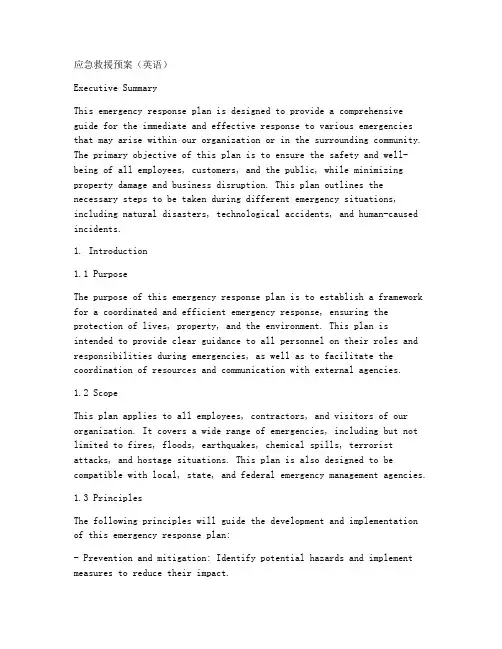
应急救援预案(英语)Executive SummaryThis emergency response plan is designed to provide a comprehensive guide for the immediate and effective response to various emergencies that may arise within our organization or in the surrounding community. The primary objective of this plan is to ensure the safety and well-being of all employees, customers, and the public, while minimizing property damage and business disruption. This plan outlines the necessary steps to be taken during different emergency situations, including natural disasters, technological accidents, and human-caused incidents.1. Introduction1.1 PurposeThe purpose of this emergency response plan is to establish a framework for a coordinated and efficient emergency response, ensuring the protection of lives, property, and the environment. This plan is intended to provide clear guidance to all personnel on their roles and responsibilities during emergencies, as well as to facilitate the coordination of resources and communication with external agencies.1.2 ScopeThis plan applies to all employees, contractors, and visitors of our organization. It covers a wide range of emergencies, including but not limited to fires, floods, earthquakes, chemical spills, terrorist attacks, and hostage situations. This plan is also designed to be compatible with local, state, and federal emergency management agencies.1.3 PrinciplesThe following principles will guide the development and implementation of this emergency response plan:- Prevention and mitigation: Identify potential hazards and implement measures to reduce their impact.- Preparedness: Develop and maintain emergency response plans and procedures, and conduct regular training and drills.- Response: Activate the emergency response plan and coordinate resources to address the situation.- Recovery: Restore normal operations and address any long-term consequences of the emergency.2. Organizational Structure2.1 Emergency Response Team (ERT)The ERT is responsible for the development, implementation, and maintenance of this emergency response plan. The team will consists of individuals from various departments, including management, security, human resources, operations, and communications. The ERT will meet regularly to review and update the plan, as well as to conduct training and drills.2.2 Roles and ResponsibilitiesEach member of the ERT will have specific roles and responsibilities during an emergency. These roles may include incident commander, safety officer, medical coordinator, communications officer, and resource manager. The ERT will ensure that all personnel are aware of their responsibilities and are trained to carry out their tasks effectively.3. Emergency Planning and Preparedness3.1 Hazard Identification and Risk AssessmentThe ERT will conduct regular hazard identification and risk assessment exercises to identify potential emergencies and evaluate their potential impact on the organization. This information will be used to prioritize response efforts and allocate resources accordingly.3.2 Emergency Response Plan DevelopmentThe ERT will develop and maintain an emergency response plan that includes detailed procedures for addressing various emergency scenarios.The plan will include information on emergency contacts, evacuation routes, assembly points, and the location of emergency equipment and supplies.3.3 Training and DrillsThe ERT will conduct regular training sessions to ensure that all personnel are familiar with the emergency response plan and their roles and responsibilities during an emergency. The training will include classroom instruction, as well as practical exercises and drills to simulate emergency situations.3.4 Communication and CoordinationThe ERT will establish and maintain effective communication and coordination with internal and external agencies, including local emergency management agencies, law enforcement, fire departments, and medical services. This will ensure a unified and efficient response to emergencies.4. Emergency Response Procedures4.1 EvacuationIn the event of an emergency requiring evacuation, the incident commander will order the evacuation and communicate the appropriate assembly point to all personnel. The safety officer will ensure the safety of personnel during the evacuation, while the resource manager will coordinate the movement of emergency equipment and supplies.4.2 FireIn the event of a fire, the incident commander will activate the fire alarm system and order the evacuation of the building. The safety officer will coordinate the efforts of fire fighters and medical personnel, while the communications officer will notify external agencies and provide them with updated information on the situation.4.3 Chemical SpillIn the event of a chemical spill, the incident commander will order the evacuation of the affected area and notify the appropriate local authorities. The safety officer will coordinate the containment and cleanup efforts, while the resource manager will ensure the availability of personal protective equipment and other necessary resources.4.4 Terrorist Attack or Hostage SituationIn the event of a terrorist attack or hostage situation, the incident commander will order the evacuation of the affected area and notify the appropriate law enforcement agencies. The safety officer will coordinate the efforts of law enforcement and medical personnel, while the communications officer will maintain constant communication withexternal agencies and provide them with updated information on the situation.5. Recovery and Continuity of Operations5.1 Assessment and CleanupAfter an emergency has been mitigated, the ERT will conduct a thorough assessment of the damage and coordinate the cleanup and repair efforts. The resource manager will ensure the availability of necessary materials and equipment, while the communications officer will keep stakeholders informed of the progress and estimated time of full restoration.5.2 Business Continuity PlanningThe ERT will develop and implement a business continuity plan to ensure the organization can resume normal operations as quickly as possible following an emergency. This may include relocating to an alternate site, rerouting communication lines, and restoring critical data and systems.6. Plan Maintenance and Review6.1 Regular Review and UpdateThe ERT will conduct a thorough review of the emergency response plan following each training session, exercise, or actual emergency. The planwill be updated as necessary to reflect changes in the organization, its facilities, and the external environment.6.2 Plan Distribution and AccessibilityThe ERT will ensure that the emergency response plan is readilyavailable to all personnel through electronic and hard copydistributions. The plan will be accessible to all employees, contractors, and visitors, and copies will be kept in conspicuous locationsthroughout the organization's facilities.7. ConclusionIn conclusion, this emergency response plan is a critical tool for ensuring the safety and well-being of all personnel and the protectionof property and the environment during emergencies. The plan provides a comprehensive framework for the preparedness, response, and recovery efforts, and outlines the roles and responsibilities of all personnel. The ERT will continue to monitor and update the plan to ensure its effectiveness and relevance, and will conduct regular training and exercises to maintain the organization's preparedness.。

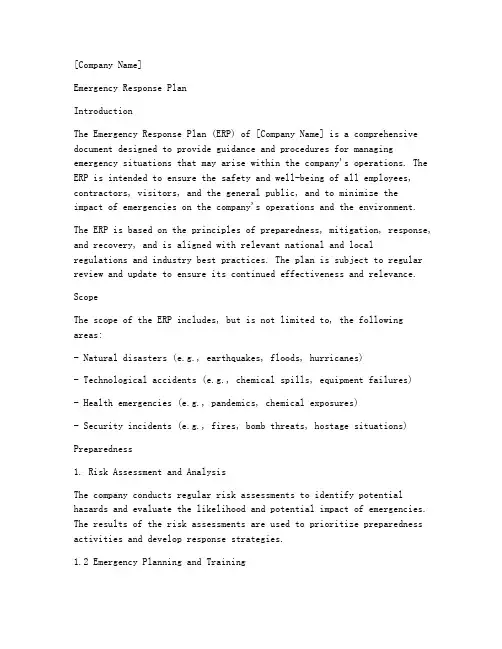
[Company Name]Emergency Response PlanIntroductionThe Emergency Response Plan (ERP) of [Company Name] is a comprehensive document designed to provide guidance and procedures for managing emergency situations that may arise within the company's operations. The ERP is intended to ensure the safety and well-being of all employees, contractors, visitors, and the general public, and to minimize theimpact of emergencies on the company's operations and the environment.The ERP is based on the principles of preparedness, mitigation, response, and recovery, and is aligned with relevant national and localregulations and industry best practices. The plan is subject to regular review and update to ensure its continued effectiveness and relevance.ScopeThe scope of the ERP includes, but is not limited to, the following areas:- Natural disasters (e.g., earthquakes, floods, hurricanes)- Technological accidents (e.g., chemical spills, equipment failures)- Health emergencies (e.g., pandemics, chemical exposures)- Security incidents (e.g., fires, bomb threats, hostage situations) Preparedness1. Risk Assessment and AnalysisThe company conducts regular risk assessments to identify potential hazards and evaluate the likelihood and potential impact of emergencies. The results of the risk assessments are used to prioritize preparedness activities and develop response strategies.1.2 Emergency Planning and TrainingThe company develops and maintains an emergency response plan that includes procedures for handling various emergency scenarios. The plan is communicated to all employees and contractors, and regular training sessions are conducted to ensure that personnel are familiar with their roles and responsibilities in the event of an emergency.1.3 Resource ManagementThe company ensures that necessary resources, including emergency equipment, supplies, and communication tools, are available and readily accessible. Personnel are trained in the proper use of equipment and supplies, and maintenance and testing schedules are established to ensure their functionality.Mitigation2.1 Hazard Prevention and ControlThe company implements measures to prevent and control identified hazards, including the use of safety devices, maintenance programs, and adherence to regulatory requirements.2.2 Preparedness MeasuresThe company takes proactive measures to reduce the impact of potential emergencies, including the development of backup systems, emergency power supplies, and the establishment of alternative communication channels.Response3.1 Incident Detection and ReportingThe company establishes a robust monitoring system to detect and report incidents promptly. Personnel are trained to recognize and report potential emergencies, and a clear chain of command is established to ensure effective communication.3.2 Incident Assessment and Decision MakingIn the event of an incident, the company's incident management team assesses the situation and makes informed decisions regarding the activation of the emergency response plan. The team coordinates with relevant authorities and external stakeholders as necessary.3.3 Emergency Response ProceduresThe company's emergency response plan includes clear and detailed procedures for responding to specific types of emergencies. These procedures are communicated to all personnel, and training and drills are conducted to ensure their implementation.Recovery4.1 Post-Incident AssessmentThe company conducts a thorough assessment of the incident and its impact on operations, personnel, and the environment. This assessment informs the recovery process and identifies lessons learned for future improvement.4.2 Recovery Planning and ImplementationThe company develops a recovery plan that outlines the steps necessary to restore normal operations and address any long-term consequences of the incident. The plan is implemented in a timely and efficient manner, with clear communication and coordination among all affected parties.4.3 Continuous ImprovementThe company learns from each emergency response and recovery effort, incorporating lessons learned into the ERP and other relevant policies and procedures. Regular reviews and updates of the ERP ensure its ongoing effectiveness and alignment with changing conditions and regulations.ConclusionThe Emergency Response Plan of [Company Name] is a critical component of the company's commitment to safety, preparedness, and responsible operations. The plan provides a framework for managing emergencies andensuring the protection of personnel, property, and the environment. The company will continue to invest in preparedness and training to ensure the effectiveness of the ERP and the readiness of its personnel to respond to any emergency situation.。
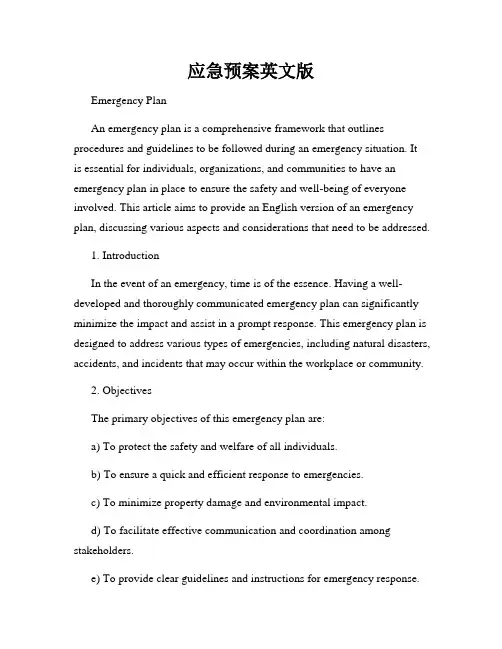
应急预案英文版Emergency PlanAn emergency plan is a comprehensive framework that outlines procedures and guidelines to be followed during an emergency situation. Itis essential for individuals, organizations, and communities to have an emergency plan in place to ensure the safety and well-being of everyone involved. This article aims to provide an English version of an emergency plan, discussing various aspects and considerations that need to be addressed.1. IntroductionIn the event of an emergency, time is of the essence. Having a well-developed and thoroughly communicated emergency plan can significantly minimize the impact and assist in a prompt response. This emergency plan is designed to address various types of emergencies, including natural disasters, accidents, and incidents that may occur within the workplace or community.2. ObjectivesThe primary objectives of this emergency plan are:a) To protect the safety and welfare of all individuals.b) To ensure a quick and efficient response to emergencies.c) To minimize property damage and environmental impact.d) To facilitate effective communication and coordination among stakeholders.e) To provide clear guidelines and instructions for emergency response.3. Authority and ResponsibilityClear roles and responsibilities are vital in emergency situations to avoid confusion and facilitate organized response efforts. The following authorities and responsibilities are outlined in this plan:a) Incident Commander: The individual in charge of overall emergency response coordination and decision-making.b) Emergency Response Team: A designated team responsible for executing specific tasks during an emergency.c) Communication Coordinator: The person responsible for managing communication channels and disseminating information to stakeholders and the public.d) Medical Team: Trained professionals responsible for providing first aid and medical assistance during emergencies.4. Emergency Types and Response ProceduresTo address a wide range of emergency situations, this plan categorizes emergencies into different types, such as natural disasters, fires, chemical spills, and medical emergencies. For each emergency type, specific response procedures are outlined, including evacuation routes, assembly points, communication methods, and necessary protective measures.5. Communication PlanEffective communication is crucial during emergencies to ensure that accurate information is disseminated promptly. This plan emphasizes the importance of establishing various communication channels, such as publicaddress systems, emergency hotlines, and social media platforms. Additionally, it provides guidelines for emergency notifications, contact lists of key personnel, and procedures for reporting and documenting incidents.6. Training and DrillsRegular training and drills enhance the preparedness and response capabilities of individuals and organizations. This plan highlights the need for conducting training sessions and emergency drills to familiarize personnel with emergency procedures, roles, and responsibilities. It also emphasizes the significance of evaluating and analyzing the outcome of these drills to identify areas for improvement.7. Continuity of OperationsIn the aftermath of an emergency, it is essential to restore normal operations swiftly. This plan includes strategies and guidelines for ensuring the continuity of essential services, such as backup power systems, alternative work arrangements, and data recovery procedures. It also emphasizes the importance of conducting post-incident assessments to evaluate the effectiveness of response efforts and implement necessary adjustments.8. Maintenance and ReviewAn emergency plan should be a living document that is regularly reviewed, updated, and improved. This plan outlines the procedures for periodic maintenance and review, ensuring that all information is up to date and reflective of the current emergency response requirements. It encourages feedback and suggestions from stakeholders to enhance the plan's efficacy.ConclusionHaving a well-prepared emergency plan is crucial for effectively managing emergencies and safeguarding lives and property. This English version of the emergency plan emphasizes the importance of clear communication, defined roles and responsibilities, and regular training. By following this plan, individuals, organizations, and communities can be better equipped to respond to emergencies, mitigate their impacts, and navigate through challenging situations with confidence.。
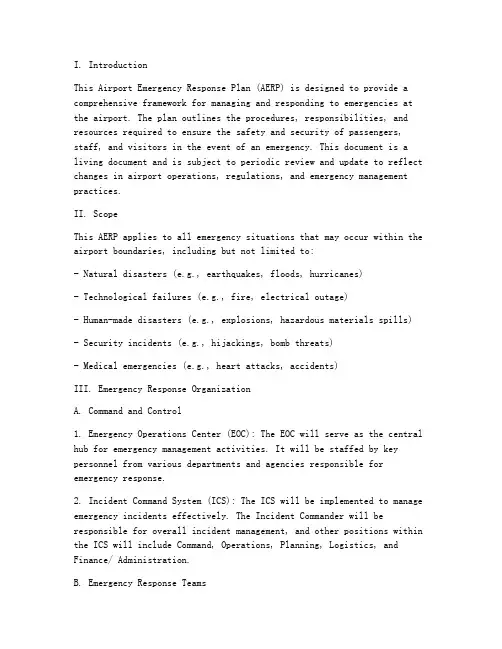
I. IntroductionThis Airport Emergency Response Plan (AERP) is designed to provide a comprehensive framework for managing and responding to emergencies at the airport. The plan outlines the procedures, responsibilities, and resources required to ensure the safety and security of passengers, staff, and visitors in the event of an emergency. This document is a living document and is subject to periodic review and update to reflect changes in airport operations, regulations, and emergency management practices.II. ScopeThis AERP applies to all emergency situations that may occur within the airport boundaries, including but not limited to:- Natural disasters (e.g., earthquakes, floods, hurricanes)- Technological failures (e.g., fire, electrical outage)- Human-made disasters (e.g., explosions, hazardous materials spills)- Security incidents (e.g., hijackings, bomb threats)- Medical emergencies (e.g., heart attacks, accidents)III. Emergency Response OrganizationA. Command and Control1. Emergency Operations Center (EOC): The EOC will serve as the central hub for emergency management activities. It will be staffed by key personnel from various departments and agencies responsible for emergency response.2. Incident Command System (ICS): The ICS will be implemented to manage emergency incidents effectively. The Incident Commander will be responsible for overall incident management, and other positions within the ICS will include Command, Operations, Planning, Logistics, and Finance/ Administration.B. Emergency Response Teams1. Airport Security: Responsible for the protection of passengers, staff, and visitors, as well as securing the airport perimeter.2. Fire and Rescue: Responsible for fire suppression, emergency medical services, and search and rescue operations.3. Law Enforcement: Responsible for maintaining public order, investigating incidents, and providing support to other emergency response teams.4. Airfield Operations: Responsible for managing airfield activities during emergency situations, including ground and air traffic control.5. Communications: Responsible for maintaining effective communication between all emergency response teams and the EOC.6. Medical Services: Responsible for providing on-site medical care and support to injured individuals.C. Support Agencies1. Local and state emergency management agencies2. Local law enforcement and fire departments3. Hospitals and medical facilities4. Transportation authoritiesIV. Emergency Response ProceduresA. Pre-Emergency Phase1. Risk Assessment: Conduct regular risk assessments to identifypotential hazards and vulnerabilities within the airport.2. Emergency Preparedness: Develop and maintain emergency response plans, train staff, and conduct drills to ensure readiness.3. Communication: Establish a communication plan to ensure effective coordination between all stakeholders.B. Emergency Response Phase1. Activation: Upon detection of an emergency, the EOC will be activated, and the ICS will be established.2. Assessment: Conduct a preliminary assessment to determine the nature and scope of the emergency.3. Notification: Notify all relevant stakeholders, including passengers, staff, and visitors, through various communication channels.4. Containment: Isolate the affected area and prevent the spread of the emergency.5. Mitigation: Implement measures to reduce the impact of the emergency and minimize damage.6. Evacuation: If necessary, evacuate passengers, staff, and visitors from the affected area.7. Medical Care: Provide medical care to injured individuals and ensure their transportation to medical facilities.8. Recovery: Restore normal operations and address any damage or disruption caused by the emergency.C. Post-Emergency Phase1. Evaluation: Conduct a thorough evaluation of the emergency responseto identify strengths, weaknesses, and areas for improvement.2. Documentation: Document the incident, response actions, and lessons learned for future reference.3. Reporting: Provide reports to relevant authorities and stakeholders, including regulatory agencies and insurance companies.4. Legal and Financial: Address any legal and financial implications resulting from the emergency.V. Training and ExercisesA. Emergency Response Training: Regularly train all airport staff in emergency response procedures, including first aid, fire safety, and evacuation protocols.B. Drills: Conduct emergency drills at least twice a year to test the effectiveness of the AERP and identify areas for improvement.C. Tabletop Exercises: Conduct tabletop exercises to simulate complex emergency scenarios and evaluate the response of various stakeholders.VI. AppendicesA. Emergency Contact InformationB. Emergency Response Plan Annexes (e.g., specific emergency procedures, contact lists, maps)C. Glossary of TermsVII. ConclusionThe Airport Emergency Response Plan is a critical component of airport safety and security. By following the procedures outlined in this document, the airport can effectively manage and respond to emergencies, ensuring the well-being of all stakeholders. Regular review, updates, and training will maintain the plan's effectiveness and readiness for any emergency situation.[End of Document]。
应急救援专业英语Emergency Rescue ProfessionalsEmergency rescue professionals play a crucial role in responding to various crises and disasters, providing essential aid and support to those in need. These dedicated individuals possess a unique set of skills and knowledge that enable them to effectively navigate challenging situations and save lives. From firefighters and paramedics to search and rescue teams, the work of emergency rescue professionals is both demanding and rewarding, requiring a deep commitment to public service and a strong sense of responsibility.One of the primary responsibilities of emergency rescue professionals is to provide immediate medical attention and stabilization to individuals who have been injured or are in distress. This may involve administering first aid, performing CPR, or transporting patients to nearby healthcare facilities. Paramedics, in particular, are highly trained in emergency medical procedures and are often the first responders on the scene of an accident or emergency. Their ability to assess and treat a wide range of medical conditions, from minor injuries to life-threatening situations, iscrucial in ensuring the best possible outcome for those in need.In addition to medical care, emergency rescue professionals are also responsible for responding to natural disasters, such as floods, earthquakes, and wildfires. These events can cause widespread destruction and disrupt the lives of countless individuals, and emergency rescue teams must be prepared to navigate these challenging environments and provide assistance to those affected. This may involve search and rescue operations, evacuation efforts, and the distribution of essential supplies and resources.One of the key skills that sets emergency rescue professionals apart is their ability to remain calm and composed under immense pressure. When faced with chaotic and potentially dangerous situations, these individuals must be able to think clearly, make quick decisions, and effectively coordinate with other emergency responders. This requires extensive training and ongoing education, as well as the development of strong communication and teamwork skills.Another crucial aspect of the work of emergency rescue professionals is their commitment to ongoing training and professional development. The field of emergency response is constantly evolving, with new technologies, techniques, and best practices emerging on a regular basis. To ensure that they are able toprovide the highest level of care and support, emergency rescue professionals must be dedicated to continually expanding their knowledge and honing their skills.This commitment to lifelong learning is particularly important in the context of specialized rescue operations, such as those involving hazardous materials, confined spaces, or high-angle rescues. In these situations, emergency rescue professionals must be highly trained in the use of specialized equipment and techniques, and must be able to adapt quickly to changing circumstances and unexpected challenges.Despite the inherent risks and demands of their work, emergency rescue professionals are driven by a deep sense of purpose and a desire to make a positive impact on their communities. Whether they are responding to a natural disaster, a medical emergency, or a complex rescue operation, these individuals are motivated by a commitment to helping others and making a difference in the lives of those they serve.In conclusion, the work of emergency rescue professionals is essential to the well-being and safety of communities around the world. Through their specialized skills, unwavering dedication, and commitment to ongoing training and professional development, these individuals are able to respond effectively to a wide range ofcrises and emergencies, saving lives and providing vital support to those in need. As we continue to face new and evolving challenges, the role of emergency rescue professionals will only become more crucial, and their contributions to public safety and community resilience will remain invaluable.。
关于直升机救援的英文描写作文Helicopter rescue is a crucial form of emergency response in many situations, including natural disasters, mountain rescues, and medical evacuations. Helicopters are able to access remote and difficult terrain, and their ability to hover and land in small spaces makes them ideal for reaching and extracting people in need of help.In the event of a natural disaster, such as a hurricane or earthquake, helicopters can be deployed to search for and rescue people who are stranded or injured. This is especially important in areas that are inaccessible by road or where the infrastructure has been severely damaged. Helicopters can airlift people to safety and transport them to medical facilities for treatment.In mountain rescue scenarios, helicopters are often used to reach climbers or hikers who have become stranded or injured in remote and rugged terrain. Helicopter rescue teams are trained to perform high-altitude rescues and can lower a rescue specialist down to the person in need of assistance, or hoist them up into the helicopter for evacuation.In medical emergencies, helicopters are used totransport critically ill or injured patients from the scene of an accident to a hospital. This is especially important in situations where time is of the essence, such as inrural areas or when the road conditions are poor. Helicopter medical evacuation teams are equipped with advanced medical equipment and trained personnel to provide life-saving care during transport.The coordination and communication involved inhelicopter rescue operations are critical to their success. Rescue teams must work closely with pilots to ensure safe and effective operations, and they must also coordinate with ground crews and medical personnel to provide seamless care for those in need.In conclusion, helicopter rescue is an invaluable tool for responding to emergencies in remote or difficult-to-access locations. The ability of helicopters to reach and extract people in need of help quickly and efficiently can make a life-saving difference in many situations.直升机救援是许多情况下紧急响应的关键形式,包括自然灾害、山区救援和医疗撤离。
英语作文-游客航空出行的紧急情况处理指南,保障安全Traveling by air can be an exhilarating experience, offering the opportunity toexplore new destinations and cultures. However, emergencies can occur without warning, and being prepared is crucial for ensuring safety. This guide provides essentialinformation on handling emergency situations during air travel for tourists.In the event of an in-flight emergency, it is vital to stay calm and follow the instructions provided by the cabin crew. They are trained to handle various situations, including medical emergencies, technical issues, and unexpected turbulence. If you experience a medical issue, notify the cabin crew immediately. Most aircraft are equipped with first aid kits and other medical supplies, and the crew can provide basic assistance or coordinate with ground medical services for advice.Should the aircraft experience sudden turbulence, remain seated with your seatbelt fastened. Turbulence is often unpredictable and can cause injury if passengers are not properly secured. Listen carefully to the captain's announcements, as they will provide updates and instructions.In the rare case of an emergency landing or evacuation, it is imperative to know the location of the nearest exits. Before takeoff, take a moment to review the safety card inthe seat pocket in front of you, which illustrates the exit locations and evacuation procedures. During an evacuation, leave all personal belongings behind to avoid delaysand follow the crew's directions to the nearest exit.If the oxygen masks are deployed, place the mask over your nose and mouth and breathe normally. Secure your own mask before assisting others, including children. The drop in cabin pressure that triggers the release of oxygen masks is typically resolvedquickly by the pilots, but it is important to use the masks until advised otherwise.In the unlikely event of a water landing, life vests are located under your seat or between seats. Follow the crew's demonstration on how to use the life vest, and do not inflate it inside the aircraft to ensure easy movement towards the exits.Fire on board is a serious concern, and the crew is trained to handle such situations. If you notice smoke or a fire, alert the cabin crew immediately. They will take the necessary actions to manage the situation and may use fire extinguishers or other equipment to contain the fire.It is also advisable to familiarize yourself with the airline's emergency procedures and policies before your flight. Many airlines provide this information on their websites or through their mobile apps.Remember, the likelihood of experiencing an in-flight emergency is low, but being prepared can make a significant difference in ensuring your safety and the safety of those around you. By understanding and following these guidelines, you can contribute to a safe and enjoyable travel experience for everyone on board. 。
关于直升机救援的英文描写作文Helicopter rescue is an important and vital operation in emergency situations. When natural disasters strike or people are in need of urgent medical assistance, helicopters play a crucial role in saving lives and providing assistance.One of the key advantages of helicopter rescue operations is the ability to quickly reach remote or inaccessible areas. Unlike traditional ambulances or rescue vehicles, helicopters can fly over rugged terrain, bodies of water, and other obstacles to reach those in need. This speed and flexibility can make alife-saving difference in critical situations.Helicopter rescue teams are highly trained professionals who are skilled in a variety of rescue techniques. They undergo rigorous training in aerial navigation, emergency medical care, and rescue operations to ensure they are prepared for any situation. Whether it's rescuing hikers stranded on a mountainside, evacuating people from floodwaters, or providing medical care in a disaster zone, helicopter rescue teams are ready to respond quickly and effectively.In addition to their speed and versatility, helicopters are also equipped with advanced technology and equipment to aid inrescue operations. From infrared cameras to spot individuals in need of rescue to winches to lift and transport people to safety, helicopters are equipped with everything necessary to ensure a successful rescue mission.Helicopter rescue operations are not without risk, as flying in hazardous conditions or conducting high-risk rescues can put the pilot and crew in danger. However, with proper training, equipment, and coordination, helicopter rescue teams can minimize these risks and successfully carry out their missions.In conclusion, helicopter rescue is an essential component of emergency response and disaster relief efforts. From natural disasters to medical emergencies, helicopters play a critical role in saving lives and providing assistance to those in need. Their speed, versatility, and advanced technology make them invaluable assets in any rescue operation.。